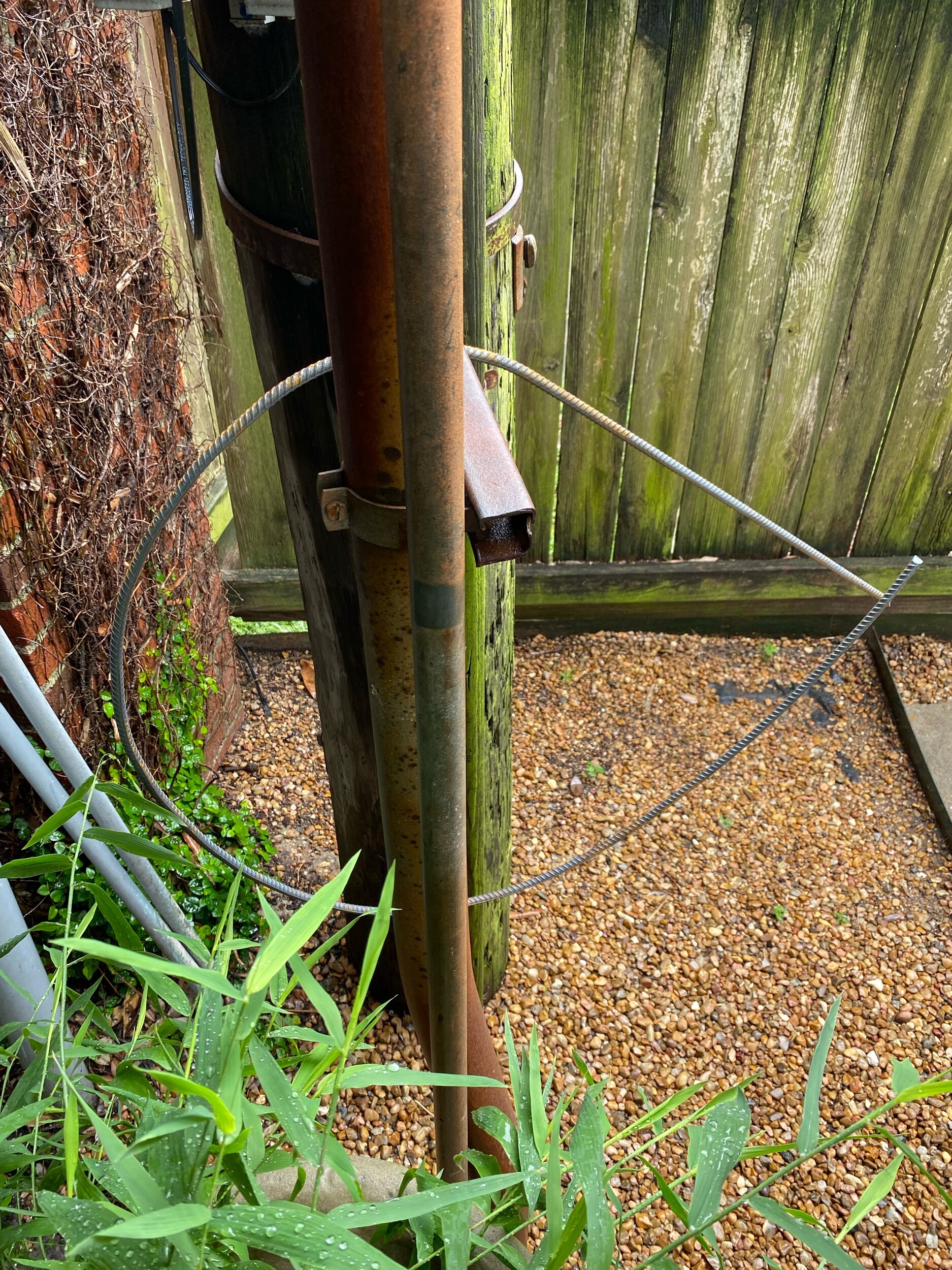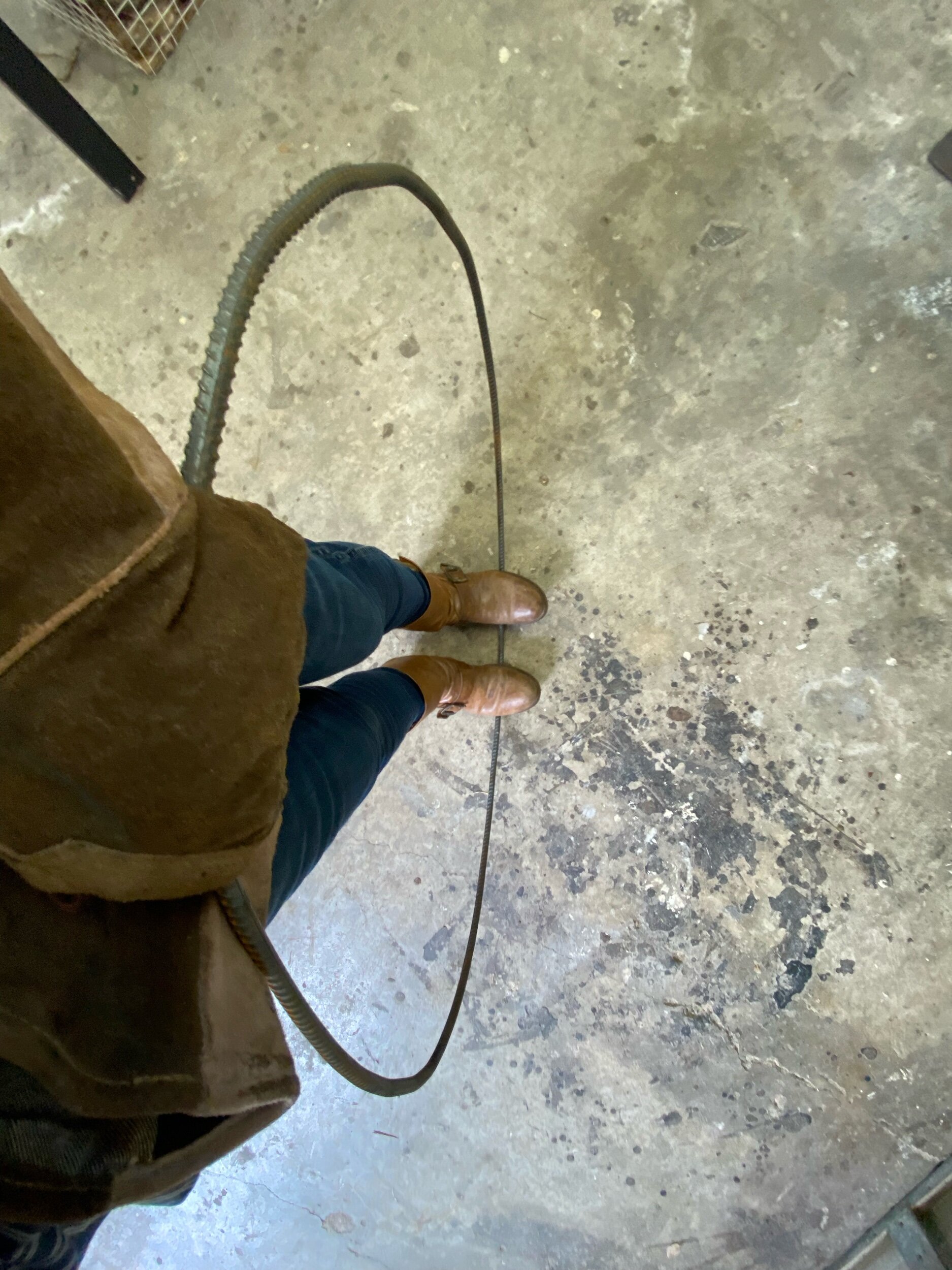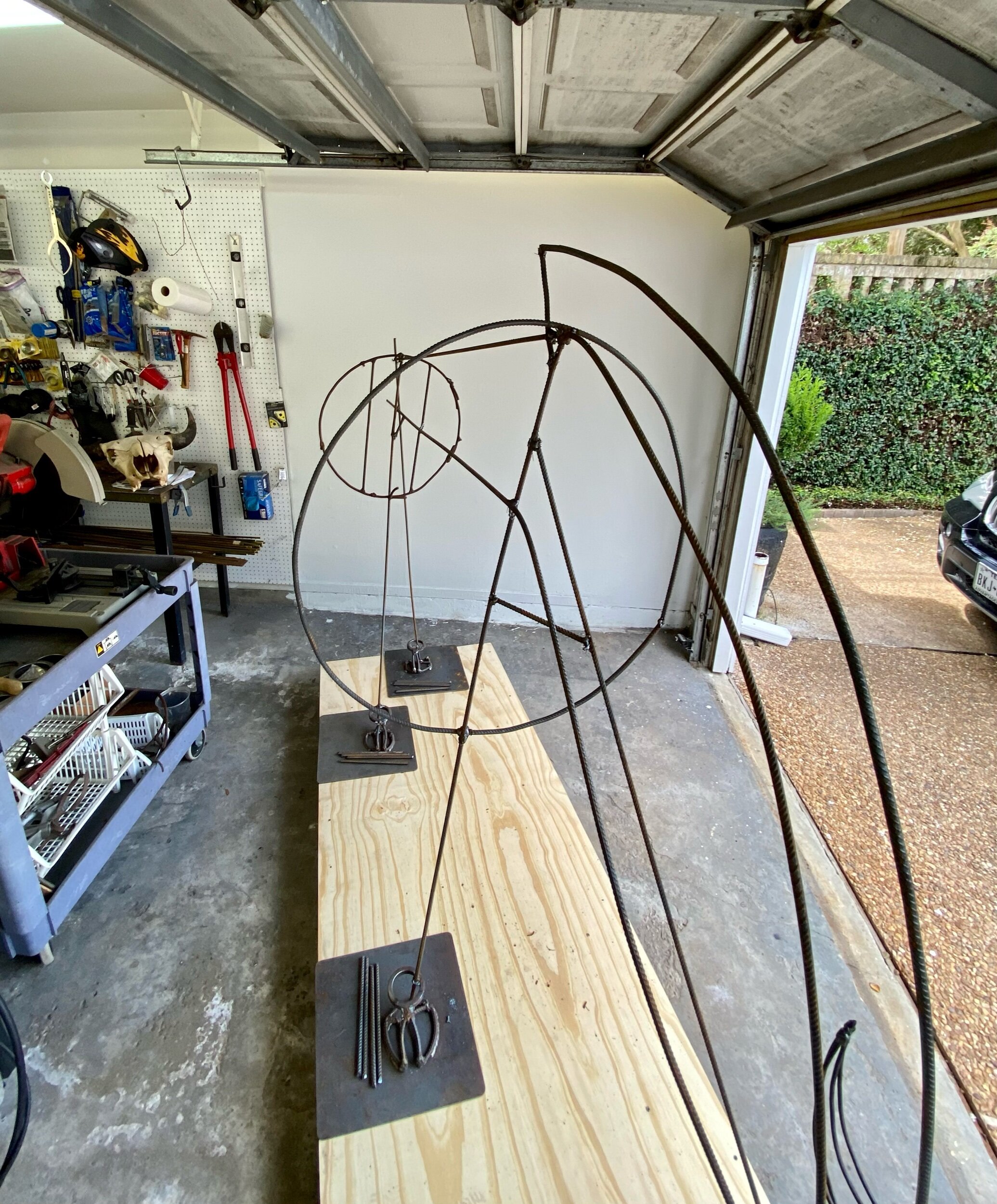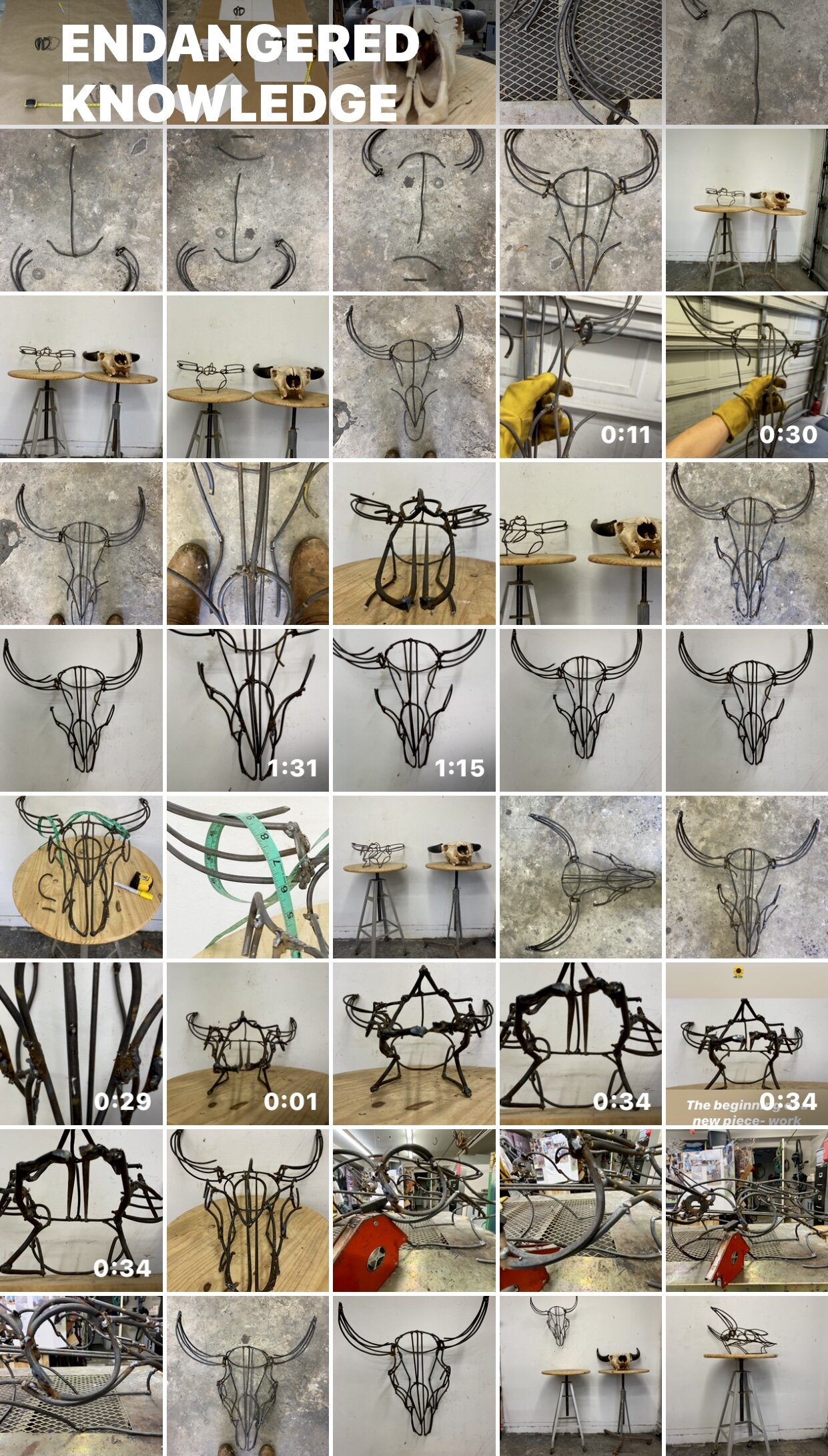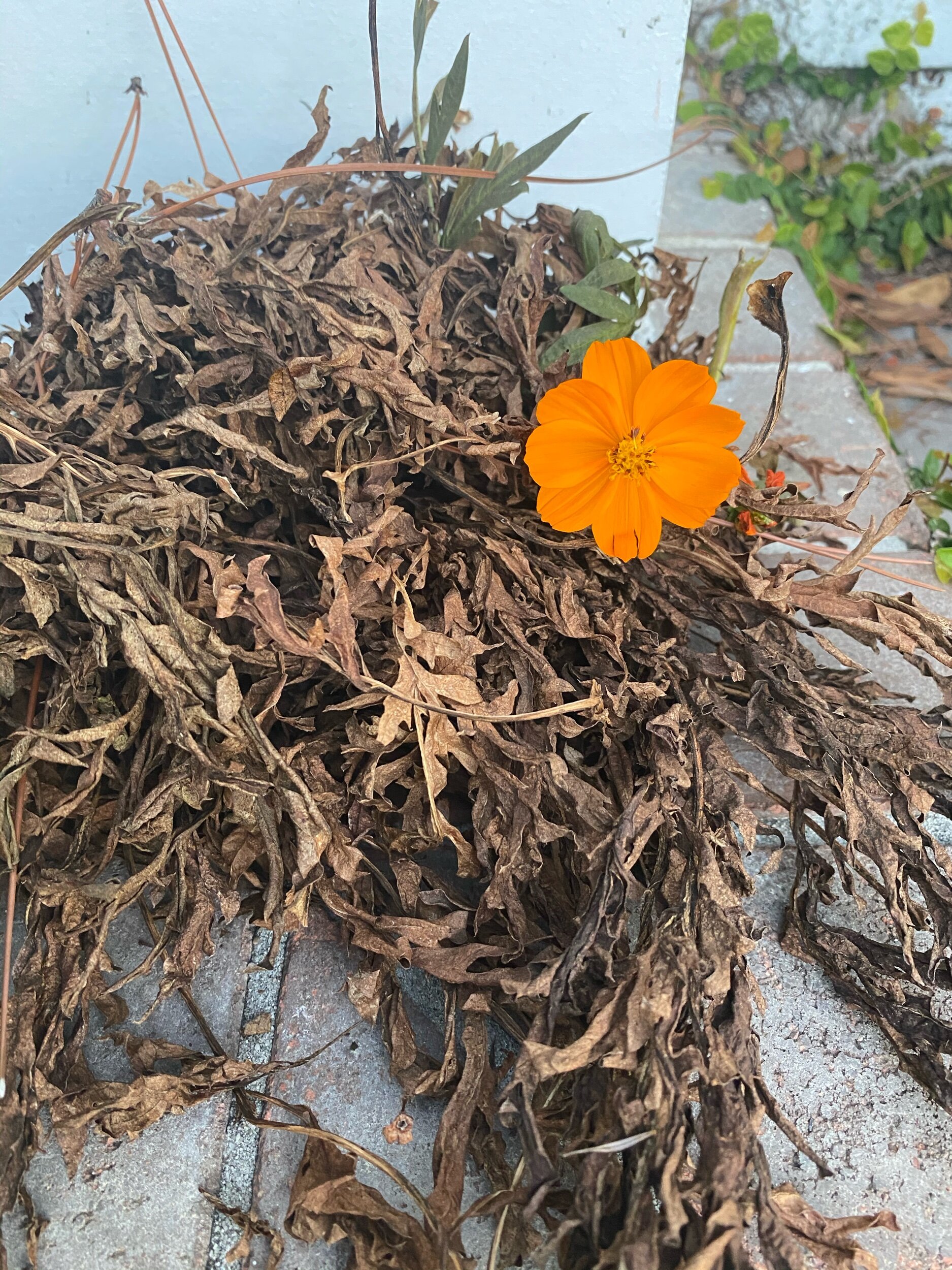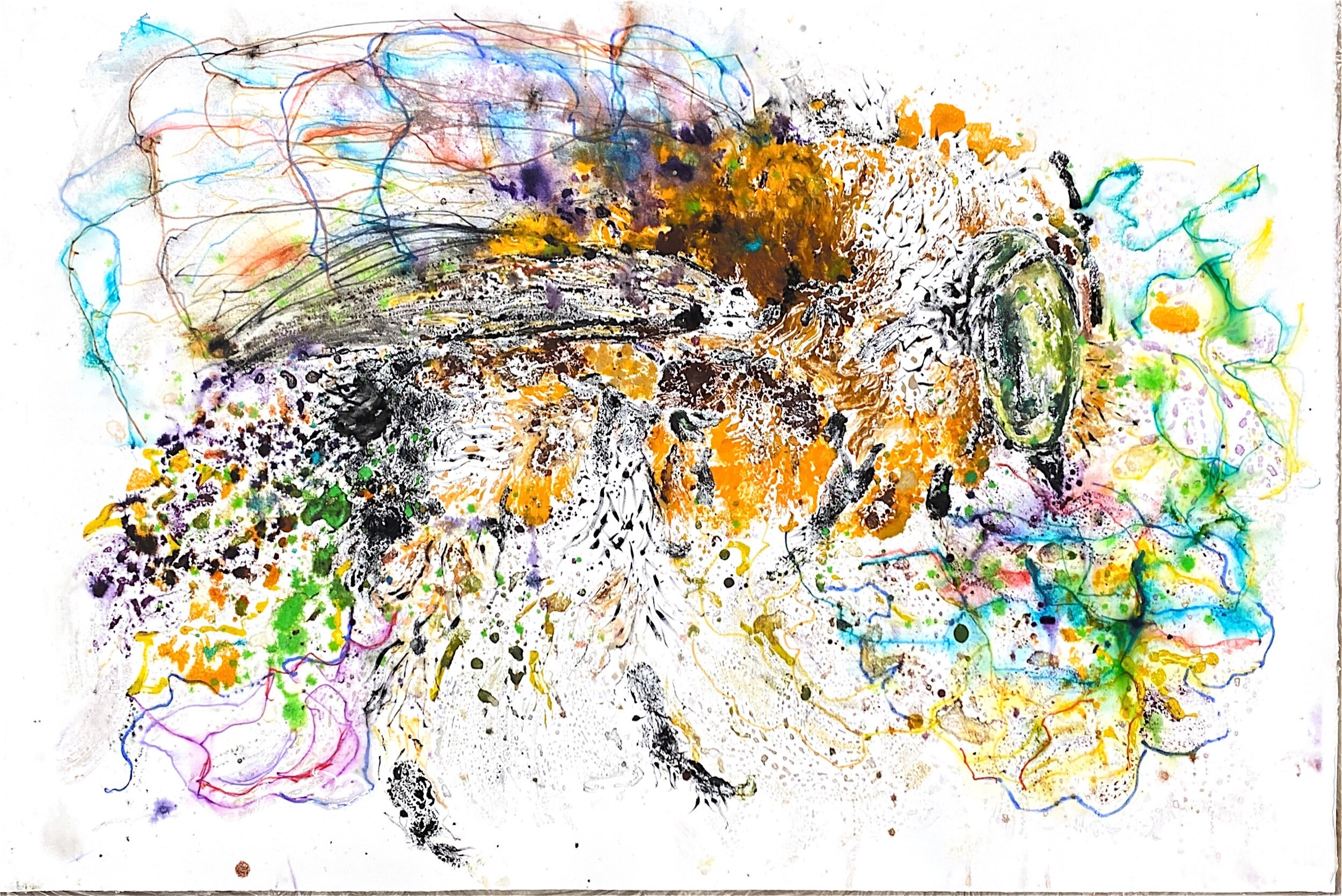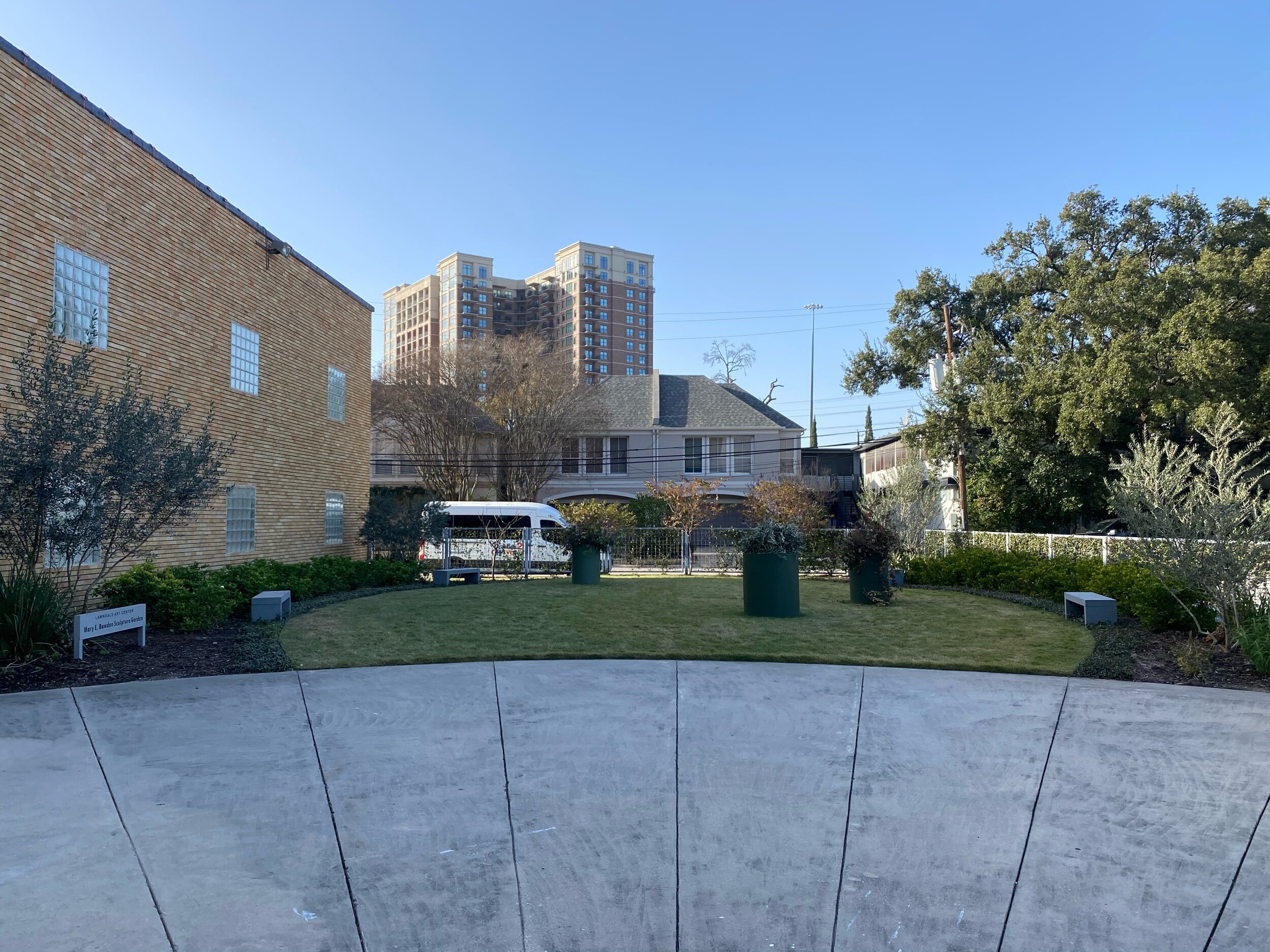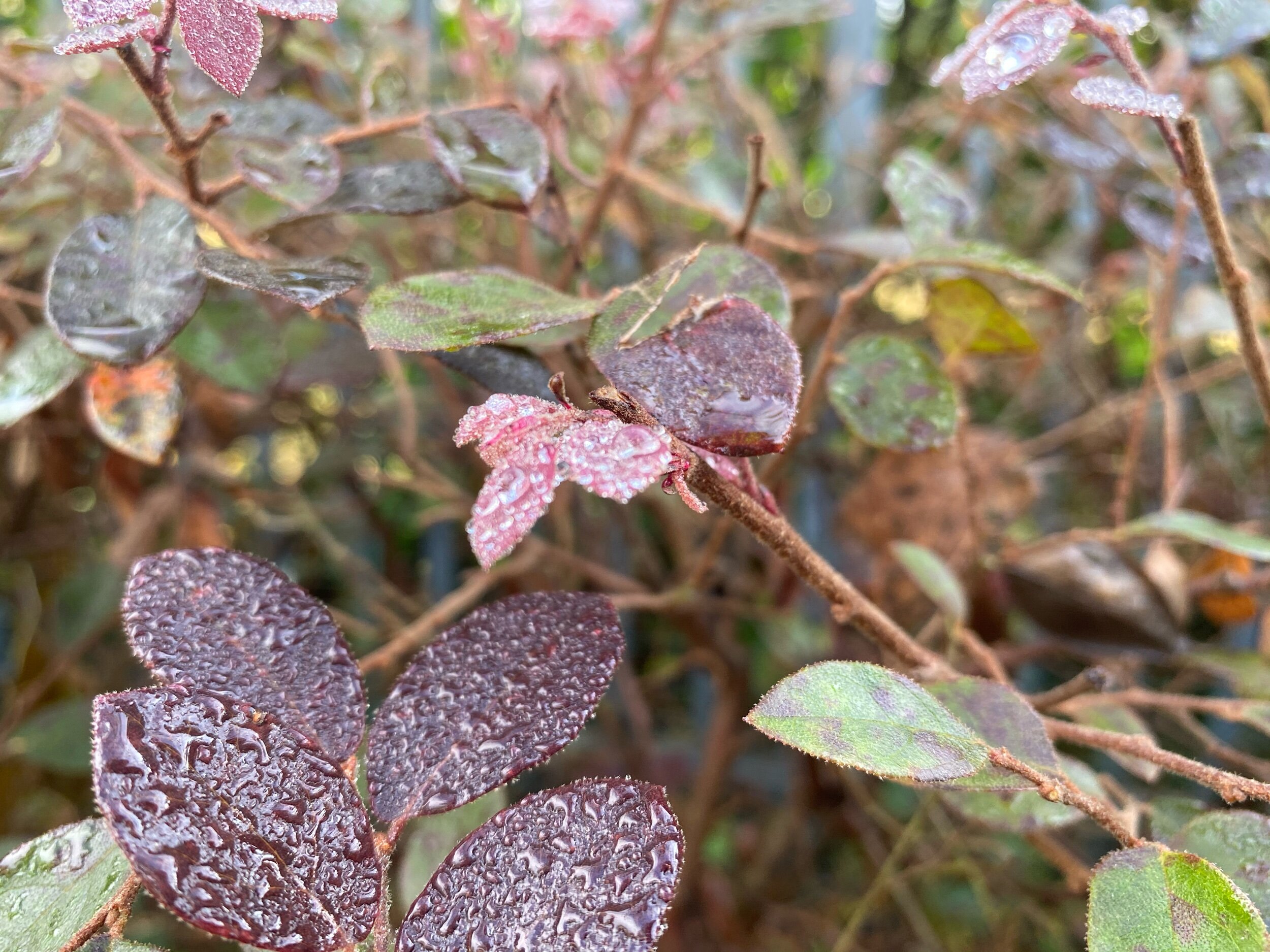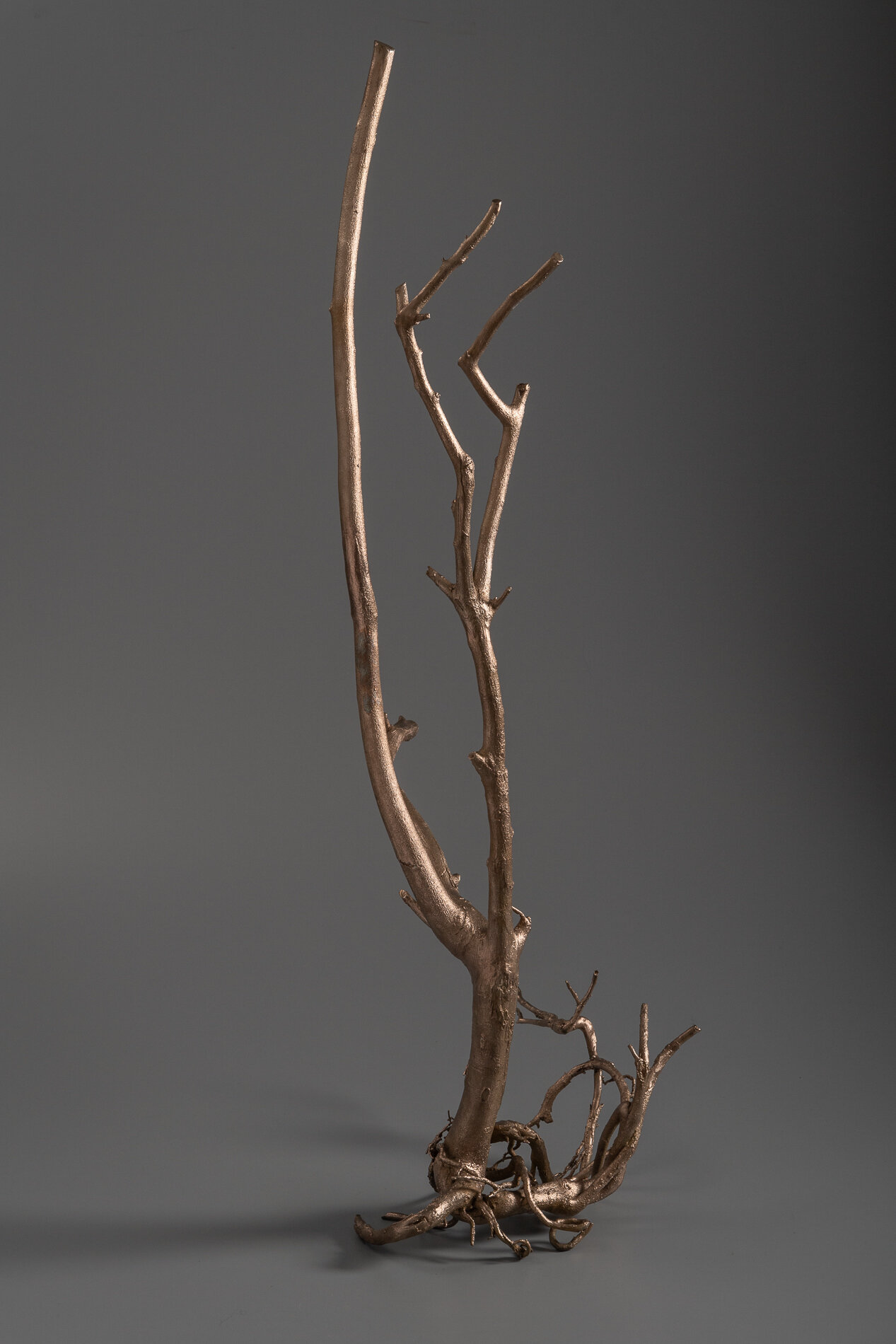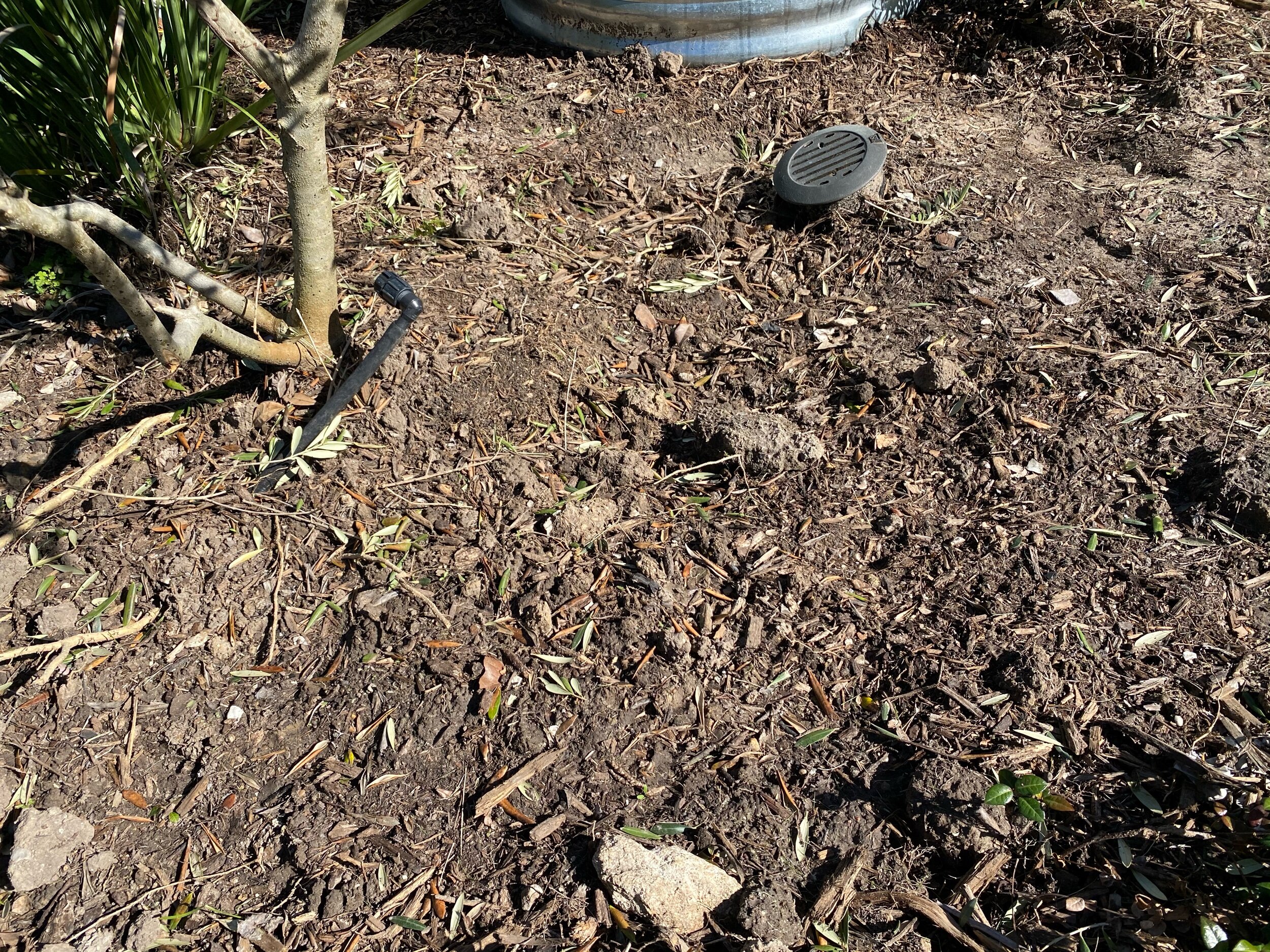Front legs and right shoulder
Endangered Knowledge: The Soul of Humus
Another big day of welding..I added a big 96” circumference chest. Put the entire piece on four dollies and started his hump. Below are a few pics from todays work.
Behind my garage is a telephone pole. I use it to bend my rebar. This is a side view where I am going to bend the piece for the chest.
Halfway to becoming a bison chest.
Then I use my weight to even out the shape.
I hang the chest over the back and decide if it is big enough.
Next I weld the ends together .
Recycling some old dollies from past work and deciding on the best plan. Balance and portability is the goal. The brown paper is the footprint of my bisons. Each leg is supported by a dollie.
Thanks to Curtis for getting me the plywood and helping me mount the beast. This is just for while I work on the sculpture and for transportation. It is not part of the work.
Just goofing around
My garage studio assistant is taking a sun break.
Starting to assemble the hump.
And that's a wrap.
Endangered knowledge: the Soul of Humus.
SMH fall of 2020 was canceled due to Covid 19 last July of 2020. I put a halt on welding my piece and focused on planning “Symbiosis.” “Symbiosis” is installed the Big Show is opened which provided a tremendous amount of traffic. I will still check on it every day, but I will spend most of my day building my piece for SMH 2021. Today I started where I left off. Below are images from last year's work and blog posts.
When I stopped in 2020 I had the hooves on steel plate bases and new where I wanted them to bare the weight.
Today I cut the rebar to form the lover part of the legs and grinded the tips. Tomorrow I weld.
Some of my notes from measuring Epics Bob the bison January of 2020.
My bison will be in motion not standing still.
The skull and upper jaw.
And lower jaw
4 pieces of rebar cut for each leg will provide the structure of the lower legs.
Endangered knowledge:The Soul of Humus
I dried some cosmos leaves to us as the coat of a sculpture that is in the works - Endangered knowledge: the Soul of Humus. The piece will be in the #sculpturemonthhouston 2021 exhibit. I started the armature during COVID for the SMH 2020 exhibit, which was postponed. The sculpture looks at the ecological history of the coastal prairie. This texture is perfect #cindeeklementart #endangeredknowledge #coastalprairie #tezasart #houstonart #bioart #environmentalart #cosmos #art #sculpture #bison
There are bees that have not been seen since the 60’s that are not listed as endangered.
After reading the document that listed Bombus Affinis as an endangered species I formed my own opinion by and it does not reflect well on the chemical industry.
Bombus Affinis - the rusty patch bumble bee
The bee that pollinates tomatoes is not the honeybee.
Summary from sciencedaily.com
The yield and quality of many crops benefit from pollination, but it isn't just honey bees that do this work: bumble bees also have a role. A team has used innovative molecular biological methods and traditional microscopy to investigate the pollen collecting behavior of honey bees and bumble bees in agricultural landscapes. It turns out bumble bees take much more pollen from different plant species than honey bees to satisfy their need for protein.
bumble bees are superior pollinators of tomatoes than the honey bee. The southern carpenter bee also pollinate tomatoes.
Turning back the evolutionary clock evolution in urban neighborhoods
4" X 13" X 8"
bronze
photo by Nash Baker
The sidewalks in my neighborhood are my nature trail. I walk with my eyes on the prowl for intriguing insects, exoskeletons, insect wings, feathers, dried flowers, twigs, leaves, seeds, and pods — things my children’s eyes taught me to find during our walks together over the years. Since 2013, these biological mementos have found their way into my bronze work in the molds of nests. Each piece is a reflection of that year’s ecology and records the time and movement of environmental restoration.
Initially, I was unaware of the landscape around me, but as my art dove deeper into environmental restoration and Hurricane Harvey changed our city, I realized that my days are, in fact, full of sterile surfaces. With COVID-19 quarantine, children in my neighborhood started venturing outside and looking for things to capture their curiosity. Delighted with their new interest, I realized that the green spaces and puddles children explore now are no longer filled with a diversity of life; the box turtles, bullfrogs, tadpoles, bumblebees, and assortments of flitting insects have evaporated with the spray of insecticides and herbicides in our neighborhoods. The selection is reduced to cicadas, the common beetle, honeybees, a rare native bee, and an abundance of Cuban lizards that dwell in turf grasses, boxwoods, crepe myrtles and oaks. I have awakened to cultural landscape uniformity. COVID has changed how I see the need for perfect lawns; the dirty truth is mosquito home-misting machines, obsessive weed control, artificial turf and a lack of plant diversity have turned urban neighborhoods into manicured monocultures for humans exploring video games. These habitat changes in massive population centers are fast-forwarding evolution: loss of wildlife habitat is one of the biggest threats facing many animal species. This does not have to be—it is a societal choice, the ability to speed up evolution can go both ways. Through my works – Lawndale’s Symbiosis, Endangered Knowledge: The Soul of Humus, Gust, World of Hum, Rumblings and Root to Water—I am committed to creating work that educates and helps communities change how we landscape our cities to include valuing the natural world and turning back evolution.
In Dirt to Soil, Gabe Brown quotes Don Campbell, “If you want to make small changes, change how you do things, if you want to make big changes change how you see.” When I come across intriguing flora or fauna on my urban trail, albeit few and far between, I see them as evidence that can inspire a revolution in the landscape. If they are expired and will not decompose, I collect them. I see these bronze cast nests as urban wildlife fossils—biographies, every year a chapter recording Houston's environmental awakening. As an optimist—environmental—art—activist my work focuses on revealing endangered knowledge to change how we see urban landscapes and activate cooling the planet through our cityscapes. As migratory birds return year after year to build nests and raise their young, I return with optimism in my step. I envision witnessing the return of four hundred plus butterfly species and eight hundred bee species native to Texas. I can see this returned wildlife capturing my future grandkids' imaginations. I will tell them the story of how insects almost disappeared and how every yard is a micro-ecosystem and matters. I imagine their hands building nests with a diversity that I cannot imagine. I hear their voices telling me in one breath about the fuzziest-biggest bee they ever saw, covered in golden dust nesting in a patch of ground beneath the sunflowers not far from the silverleaf nightshade. I see them bringing me a tail-feather from a Red Shoulder Hawk and asking, "what does it hunt" and is it the bird that sounds like the squirrel's screech. After a rain, I see them finding two bullfrogs attached and their tiny ribbons of floating eggs in a pond. I hear them tell me not to touch the caterpillar of the southern flannel moth, and asking me, “how does it sting?”. At the low of evening when dragonflies hover; I will watch as they study the night heron’s quiet solitary stance as it stalks small citizens of the grass, I will smile as they question the raucous warnings of ravens and the scoldings of nut collecting squirrels. I will feel their excitement when neighborhood raccoons appear from storm sewers and scavenge treats from dog bowls and opossums waddle fence lines, searching out grubs and open garage doors. I will follow their eyes when the silent patrol of the lone coyote visits the shadows of our boulevards from their bayou bound dens. I let them sleep outside and hear their heavy eyelids ask, why do the owls ask who? I listen as they wake up to a concert of white-winged doves. I will feel peace when they are wise to nature.
Lawndale Art Center - symbiosis
In a nutshell, this is what I hope to achieve with my site-specific piece, Symbiosis.
I am rethinking the uses of yard clippings.
Lawndale - Symbiosis - extractive
In Symbiosis I am stretching my practice and creating a living piece of site-specific art activism that will reimagine a 53.5’ X 48’ traditional urban landscape/sculpture garden and answer the question: how do we holistically restore an ecological balance in Houston? Symbiosis is a collaboration with Lawndale Art Center’s community, neighbors, urban wildlife, and the coastal prairies carbon cycle.
The west border of the garden has five 1 1/2 year old Crepe Myrtle’s a tree famous for murder. The murder refers to badly pruning the tree- down to the knuckles. I was not having these Crape Myrtle’s murdered. Today I used a extractive method of sculpting and clipped- nipped - and cut the existing branches. I shaped the branches/armature of the two end trees.
A sculpture garden has the four seasons of the year and a sculpture garden has the additional change of exhibitions. The pedestals from the last exhibit were still in the garden. 🤔perfect way to highlight the beauty in the wild- the imperfect- the not immaculate urban landscape.
FYI- crepe Myrtle’s are not native however they are a cherished gift to the Art Center. As an optimistic art activist I look at the project holistically to include the desires of the Art Centers board.
When I work in wire, or steele if I cut too much I can always weld it back it add more wire they are forgiving materials. When I clip a branch it is gone- no second chance. .
#artactivism #cindeeklementart #symbiosis #lawndaleartcenter #nativeplants #coastalprairie #sculpture
Create Myrtle cuttings wildly place on a pedestal.
North West Crepe Myrtle after pruning.
Cuttings from two Crepe Myrtle's and the olive trees from a few weeks ago.
South end Crepe Myrtle
Lawndale’s Symbiosis - constant research
Symbiosis is a long term art installation. A piece of dirt in the middle of a large US city, an ecosystem that serves the local art community. Through pairing my intuitive sculptural practice, and natural history research I am sculpting the garden into an ecosystem that balances the needs of the Homo sapien art community and the urban natural world. I spend much of my time filtering through biologist research, inspirational documentaries and interviews of individuals that are leading the way. New Year’s Day I listened to a remarkable podcast an interview of Nora Bateson who is an award-winning filmmaker, writer and educator, The podcast was taped before the pandemic. She knows what she is talking about. Here are two quotes from the podcast that gave me pause and reminded me how grateful I am for my opportunity to make a difference through Symbiosis at Lawndale
“ In my little fantasy there is a great big pause button, and we can say hold everything, let’s regroup, let's turn this titanic around”
“One way or another the systems that we are within are going to change.”
A very enlightening podcast regarding how change and regeneration happens. It is haunting to consider this came out before the Covid 19 quarantine of 2020. Everything Nora talks about addresses the things I am thinking about. She is most definitely an influencer. I will continue to follow and monitor her work.
You can find the interview at The Regenarration podcast on Soundcloud Solve Everything at once.
Checking on the garden I found a moth that was still alive laying in the Pond. I rescued him and laid him out to dry.
Subterraneous Secrets - how plant roots communicate with microorganisms
Lawndale symbiosis - milkweed and monarchs
I have read that a few migratory monarchs spend the winter in the Houston area and join a small resident population of monarchs. I have also read that it is essential to choose native milkweed as opposed to tropical. Tropical milkweed—doesn’t die back in the winter as native milkweed does. When a place to lay their eggs year-round is available, many monarchs don’t bother making the trip to Mexico.. I saw this caterpillar on my morning walk. It was seriously munching on the milkweed. Milkweed is the only plant that provides the nourishment that will transform the caterpillar into a monarch butterfly. It is important to plant only none-hybrid native milkweed. Texas milkweed will be included in my 2021 Lawndale Art Center Sculpture garden piece Symbiosis. In Symbiosis, I am stretching my practice and creating a living piece of site-specific art activism that will reimagine a 53.5’ X 48’ traditional urban landscape/sculpture garden and answer the question: how do we holistically restore an ecological balance in Houston? Symbols is a collaboration with Lawndale Art Center’s community, neighbors, urban wildlife, and the coastal prairies' carbon cycle. For more details see this link.
#carboncycle #cindeeklementart #texasart #houstonart #contemporaryart #modernart #caterpillar #monarch #milkweed #nativeplants #migration #energy #movement
#lawndaleartcenter #symbiosis #artactivism
The day after the caterpillar sighting.
The beauty of a leaf runs deep.
How beautiful droplets of dew or rainwater puddle on the waxy leaf surfaces? They provide the watering holes for nature’s tiniest creatures.🐞🐛🕸️🦎🐌🐸🐜🦋🐝
What do you see when you see a leaf? ☘️🌿🌱🍀
I see a unique natural system. Leaves multi-functioning as micro reservoirs, coats of armor protecting the soil, and micro floodgates slowing rainwater. 💦🌊💧
On the Coastal prairie, leaves function to protect the soil from being compacted by the pelting raindrops. If the heavy raindrops fall is not broken by layers of leaves and organic matter, the tiny cavities in living soil collapse, and rainwater moves horizontally across our landscape instead of into the tiny reservoirs in the soil. We need these small cavities to allow water to penetrate deep into the soil. Leaves also slow rain droplets giving the soil time to transport the rain to its deepest roots. Once the rain is in the ground cooling our planet leaves protect the soil from the heat of the day. This multilayered ground cover gives rain more time to trickle into the aquifer. Purifying our water and cooling our planet. How amazing are leaves? As an artist my how we see urban landscapes
My work records endangered knowledge to the collective memory and reimagines urban landscapes to holistically balance the needs of humanity and wildlife.
In Symbiosis I am stretching my practice and creating a living piece of site-specific art activism that will reimagine a 53.5’ X 48’ traditional urban landscape/sculpture garden and answer the question: how do we holistically restore an ecological balance in Houston? Symbiosis is a collaboration with Lawndale Art Center’s community, neighbors, urban wildlife, and the coastal prairies carbon cycle. #symbiosis #lawndaleartcenter #urbanlandscapes #artadia #coastalprairie #water #leaves #conservation art #bioart #nature #contemporaryart #modernart #artactivism #cindeeklementart #texasart #houstonart
Symbiosis- fluffy bluestem
Through art, I am finding new ways to see Houston’s urban landscapes. The bushy bluestem is a coastal prairie native and a volunteer at Lawndale art center, the location of my 2021 site-specific sculpture installation.
For creating movement and living soil, bushy bluestem is a fabulous material to consider. At this point, I do not know if it will make the cut of materials for the sculpture; however, it does have some attractive characteristics as a material for living soil, and aesthetically I think it is beautiful. The spikelets of silky feathers curl out of a sphere of fine hairs. It is tall and graceful, peering five feet off the ground. In my mind, I can see a cluster of them suited in costumes of golden cotton candy swaying across the stage of coastal prairie under the spotlight of our earth's closest star. Their rhythm succumbs to the breeze that sweeps off the coast. They create the perfect; kitchen of seeds for birds and small mammals, cozy nesting materials for birds, winter food for prairie chickens, field sparrows, and juncos. I can hear a symphony of songbirds serenading the morning as butterflies flit, and flingle and native bees start their day. With close inspection and a little luck, you may even discover a Skipper or Satyr larvae starting a new life amongst their stems. #symbiosis #cindeeklementart #livingsoil #sitespecificart #texasart #bushybluestem #houstonart #texassculpture #contemporaryart #nativebees #bees #wildlife #livingsoil
Changing how we see urban landscapes in Houston.
Grasslands vs. trees
When it comes to the environment in the 21st century grasslands beat trees when it comes to carbon sequestration. Our planet is a living breathing organism, impacted by our actions, always changing. I believe It is important that we constantly observe and evaluate how it changes as humans developed and expand across it.
Trees are a thing of beauty but they store carbon above ground in their trunks and limbs.when they catch on fire the trunks and limbs release their carbon into the atmosphere. Grasslands storing carbon underground release little carbon when they catch on fire. In addition the grasslands are a giant sponge soaking up water that prevents dryness and fires.
With the forest fires we have suffered world wide it is time to plant more grasslands and turn these areas suffer ending from droughts into giant sponges for soaking up water and carbon. When the ground is moist then we can can start adding back trees.
Drying coastal prairie native grass in my studio.
ROOT TO WATER
”Root To Water” 24” X 12” X 12” irrigation wheel and root found objects.
“How fleeting are the wishes and efforts of man! how short his time! and consequently how poor will his products be, compared with those accumulated by Nature during whole geological periods.”
—Charles Darwin, Origin of the Species
Root to Water offers hope. The root, placed with the root system up, takes on anthropomorphic characteristics, as the wide spread irrigation wheel’s legs are firmly grounded, the humanized root’s bent over posture and downward pointing arm are alive with discovery, the root’s hair like tendrils are actively rewiring its human anthropomorphic brain. This rewiring is happening across the globe, in the most desolate of landscapes citizen conservationists are studying natural law and finding solutions to their man-made problems.
In Root to Water, the irrigation wheel symbolizes mechanistic systems. The root in its natural state represents ecological systems. With this duo, I propose that modern civilization has reached an advanced stage of industrialization. In order to progress to the next stage of civilization we must heed Darwin’s observation, and answer the question how do we pair mechanical innovation with the systems that have functioned through “whole geological periods.” I placed the root above the wheel supporting Darwin’s view of natural systems superiority to human innovation.
Repurposing two tools from agronomy, Root to Water shifts how we see mechanical systems versus naturally occurring systems. In this sculpture, a modern innovation—a rusting, decorative, human-made irrigation wheel—serves as a pedestal for an organic found object that often goes unseen: a root system. With this pairing, I exhibit man’s historical struggle to transition to an agricultural-based society utilizing human-made innovations that extract natural resources instead of harnessing existing ecological systems that regenerate resources.
Communities across the planet are experiencing extreme cases of natural disasters. Houston has experienced three 500-year floods in three years. The U.S. Army Corps of Engineers completed the Buffalo Bayou and Tributaries Resiliency Study, proposing options for controlling flood waters costing up to $12 billion. The report does not include conveyance options that are local nature-based cost effective solutions.
A growing number of conservationists are using natural systems, specifically roots, as a tool for water transportation, carbon sequestration and as a means to cool the planet. Meanwhile, industrial agricultural produces products that are depleting the organic matter, releasing carbon from the soil, and contributing to global warming. As evidence consider, “Each 1 percent increase in soil organic matter helps soil hold 20,000 gallons more water per acre.” In contrast, industrial methods strip the soil (releasing carbon), use petroleum-based inputs to enrich the soil and kill pests. Root to Water elevates roots as a natural system that transports water, minerals and carbon; stabilizes soil; and is instrumental in cooling Earth’s surface—a live-able solution for global warming.
My research-based art looks at the natural history of living soil and how it can be used to restore natural resources that is not commonly understood. I champion natural solutions to environmental issues with a focus on urban landscapes. Root to Water is part of my Endangered Knowledge work, a body of work in progress.
“Though the problems of the world are increasingly complex, the solutions remain embarrassingly simple.”
—Bill Mollison
Further Reading
-Judith D. Schwartz, The Reindeer Chronicles, Water in Plain Site, and Cows Will Save the Planet
-Kiss the Ground, Directed by Joshua and Rebecca Tickell, with WoodyHarrelson
-Organic Matter Can Improve Your Soil's Water Holding Capacity
-The Loess Plateau was the, most highly erodible soil on earth”
Talking roots.
How roots talk to each other. My focus is coastal prairie roots, but I expect roots of grass communicate as tree roots communicate. We gave only begun to learn from roots.
SUBTERRANEOUS SECRETS IV
36” X 8” X 8”
bronze
photo by @nashb Baker
Since the beginning of time, the human spirits' imaginations have been magnetically allured beyond the earth's geomagnetic field, inventing robots, orbiters, landers, and rovers to explore outer space, searching for celestial organisms — fruitlessly.
Secretly between 100 million and 500 billion microbes per teaspoon are living a subterranean life underneath our feet. Living soil is the root of our existence; it is essential to life on Earth. For several years, I have researched grass-fed food production, attended soil conferences, and visited regenerative ranches. (my favorite is @roamranch) Research in these fields reveal how to fight desertification and reverse climate change through regenerative agriculture practices. Interestingly, this natural history of living soil, how it evolved with roots, fungus, plants, food, and animals, carbon and their essential roles within microbial communities in human health, is not common knowledge. Subterraneous Secrets excavates this crucial tool in storing carbon. My work finds new ways to reimagine urban landscapes and records natural history to the collective memory so that it will no longer be endangered knowledge #roamranch #cindeeklementart #bioart #conservationart #environmentalart #root #bronze #bronzesculpture #pesticidefree #texasart #texasartist #houstonart #houstonartist #houstonsculpture #nature #naturalsystems
Symbiosis building soil life.
How do you build soil health without having the luxury of animal impact. It is one thing to build soil health on a bison farm. The microbes in the the the bison, turkey, pig and chicken dung builds the life in the soil. In the sculpture garden at Lawndale I am going to use LEAF MOLD COMPOST. This product is produced primarily from recycled leaves, with a little grass and horse manure mixed in, a touch of fruits and vegetables. After a long slow compost it will be rich in beneficial microbes. It will help save water and promote healthy soil. I was going to wait until early spring before we replanted the garden. However, Sunday Lawndale is having it's Sunday brunch fund raiser. And this is in the day if Covid 19 so the event is outside. I noticed that the heavy rains of late have compacted several areas in the beds and washed away some soil. It will be an opportunity to to talk about living soil,
I spent time researching different types of compost and mulch. Natures Way Resources compost native plants, is locally owned and located in the Houston area. The owner is a soil scientist. I had a long conversation with him today and he really knows living soil. I can't wait to see life return to the garden.
Here you can see how the soil is wearing away without having plants/roots hold it down. You can also see how the rain hitting it had compacted the ground. When the soil becomes compacted it stops absorbing water. .
The goods
The tools
Happy Soil Day.
Happy National Soil Day. Notice the length of the root system of this turf grass-just a few inches. 👎
🤔
The image I posted is not soil to be celebrated.It is what I call mindless conformity 🤨AND - now for the good news- 🌱☘️🍀☘️🌿
It is an opportunity to help save our planet and that we should celebrate.
Let me explain- this is the typical ground cover that covers 99.99% of the homes in the United States. It is a mono-crop of turfgrass. Monocrops are not healthy for soil. Mother Nature needs diversity to be healthy. To go against nature, homeowners have to apply chemical inputs to keep their monocrop turf grass looking perfect. These fertilizers, fungicides, herbicides, and pesticides kill all the living matter. They also kill our insects and valuable Keystone species.
In contrast, healthy soil, especially on the coastal prairie, is a sponge for soaking up rainwater and keeping our planet cool. Houston was a coastal prairie covered in native grasses that had massive roots systems. Some extended 18’. The coastal prairie has the capability to absorb massive amounts of moisture/water. They also act as a filter to clean the water and retain water. Water held in healthy soil is how the planet cools itself. Healthy soil also sequesters carbon out of the air and puts it back into the soil. The coastal Prairie plays a large role in the global environment. Houstonians have paved, asphalted, and covered in turf grass 600 square miles that makeup Houston. Reimaging urban landscapes is an opportunity to save our planet. Turfgrass covers more acreage in the US than farmed land. 🤠 this is an easy way to comply with mother nature. I am using ny art to find ways to reimagined urban landscapes to work with mother nature Healthy soil= healthy people. Happy soil day. #cindeeklementart #artactivism #bioart #soilart #art #conservationart #soil #regenerativeart.
Shoutout HTX
Anytime an organization or individual takes notice of my work it is a gift. Thank you Shoutout HTX for supporting me and other local artists.



